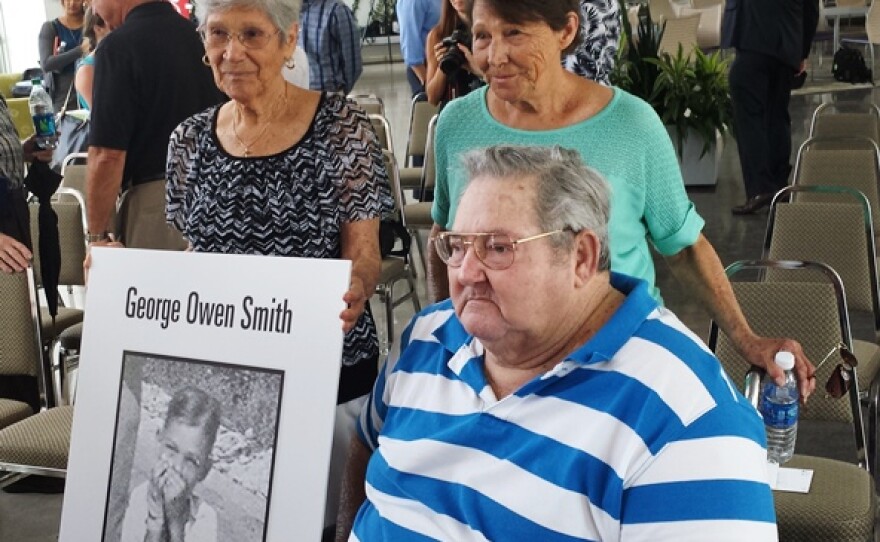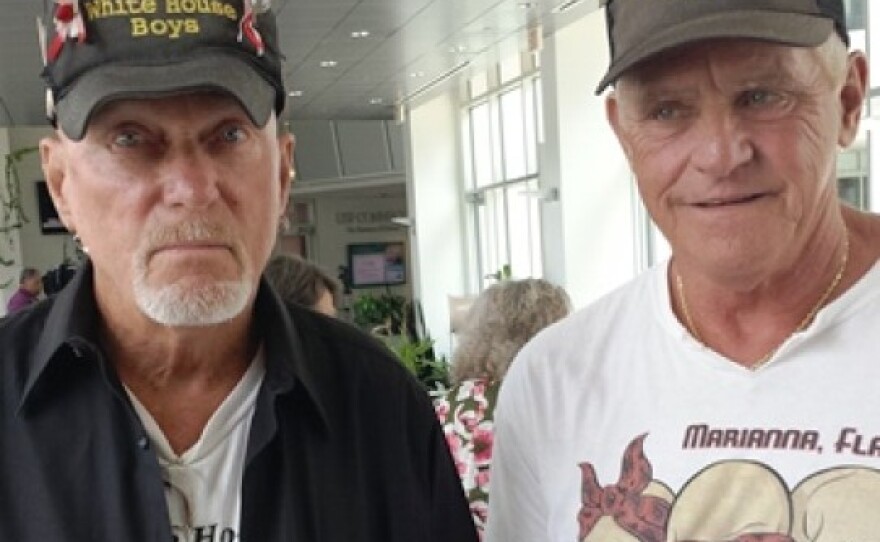Ovell Krell was only 12 years old when her brother died -- but what she remembers most about him was his musical ability.
"He could walk into a music store and pick up any instrument they've ever made and within two minutes, he could play it," she said.
George Owen Smith, 14, tried to teach his sister how to play music, but those lessons stopped in 1940 when he was sentenced to the Arthur G. Dozier School for Boys after being caught in a stolen car with a 19-year-old friend.
Shortly after arriving at the reform school in Marianna, Fla., Smith reportedly escaped, but was found dead several months later under a house two miles away.
"Though the family told authorities to hold his remains at a local funeral, as they made their way on the long journey from Auburndale in a borrowed car, they arrived to be shown a mound of dirt by a superintendent who said that they had just buried him in an unmarked burial ground," according to University of South Florida associate professor of anthropology Erin Kimmerle.
That superintendent promised that a name plaque would be placed on Smith's grave -- a promise that was never met. Because of the mysterious circumstances of his death and the nature of his burial, Smith's mother refused to believe her son was indeed dead. That led Krell to make her parents a promise.
"I was searching for him, not only out of my love, but for a vow that I had made my mother and father on their deathbeds that I would find my brother if it was in my power, I would look till I died," Krell said.
Now, Krell has found her answer, thanks to a team of USF researchers.
For the last three years, a group of anthropologists led by Kimmerle has tirelessly studied the Dozier School, which was closed in 2011 after decades of allegations of abuse and violence against students. That work led to the exhumation last year of remains found in 55 unmarked graves on school grounds.
According to USF professor of anthropology Christian Wells, the first set of remains exhumed was the least preserved -- buried barely two feet underground, in a coffin much too big for the body.
In addition, unlike the other, fully-clothed remains, this one was naked, wrapped only in a burial shroud. All that was left were the skull, parts of his hands, his lower legs and his feet.
"We were very fortunate to get the skull and some teeth because we're using the teeth and the roots from the teeth to develop the DNA profile so we were very, very lucky on this one," Wells said.
That DNA profile, along with those from the other remains, were worked up by researchers at the University of North Texas Health Science Center in Fort Worth, Texas. The results were compared to samples taken from living family members of some of the boys believed to be buried in the graves.

"There was a lot of suspicion that this process would not work out, that the DNA would be too degraded, the remains too decomposed to make any of these matches, but this really proves it, especially in this case where this was one of the most decomposed burials," Wells said.
Yes, the least preserved body provided the first name: George Owen Smith.
Erin Kimmerle picked up the phone to call the now 85-year-old Ovell Krell.
"I was very excited to tell her so I probably mumbled a lot more than I normally would, but I just said, 'Ovell, we have a match and we've found your brother, we have Owen,'" Kimmerle said at a news conference formally announcing the match.
"It is the answer to my family's prayer that we can take him back, put him with my parents and maybe we can all get some peace and closure," Krell said.
The formal announcement came only days after Krell's 70-year-old brother Carlton Smith died. Of the seven children in the Smith family, only Krell and two siblings are still alive.
Kimmerle said figuring out how Smith died would be very difficult due to having so few remains. A state medical examiner will try to make an official determination.
But even with Smith identified, the dozens of other sets of remains still lack names. While DNA profiles are in the works, UNT Health Science Center technical leader Dixie Peters says they only have a handful of samples to match them with.
"Unfortunately, we've only received 11 samples from different family members, but they represent nine families who have missing loved ones, and so unless we obtain a lot more family reference samples, it's going to be difficult for us to continue to make additional associations," Peters said in a conference call with reporters.
That makes finding answers difficult, which bothers many, including Florida Attorney General Pam Bondi.
"I mean, these are kids, and these kids deserve and will have a proper burial with the dignity and respect that they deserve," Bondi said.

Officials hope that any boys who aren't identified will be re-buried at Dozier and memorialized in a concrete way.
Bondi, along with Florida Chief Financial Officer Jeff Atwater and U.S. Sen. Bill Nelson, have come out in support of USF's efforts at Dozier. The Florida Cabinet (Bondi, Atwater, Commissioner of Agriculture Adam Putnam and Governor Rick Scott), as well as the Florida Department of Environmental Protection, have extended the researchers' permit to continue their work at Dozier through Aug. 5, 2015.
This kind of government assistance is a welcome change to Bill Price.
Price, a burly, white haired man in his mid 60s, is a member of a group of former students known as the White House Boys, named for the small white shack where they say they were brutally beaten by school administrators.
For years, the group, along with other former students like the Black Boys at Dozier, have fought the state to acknowledge what happened to them. Now, many officials are standing on their side.
"Not everybody is without a heart, you know what I mean?" Price, who was at Dozier from 1961 to 1963, said with a hearty laugh. "Some people are looking at the wallet and some people are flying from the heart, and these people that are helping us are from the heart. They want to make sure that these people be reunited with their loved ones and have them buried properly and I love it."
Price said that giving the first set of remains an identity is "the greatest thing ever." He added that the surviving students, now grown men, will continue to speak up for their voiceless classmates, like the one boy whose body was exhumed with a single marble in his pocket.
"And our symbol now, because of what Erin found, every White House boy you see will have this -- the marble in their pocket," he said as he fished a tiny brown and white orb from his pocket and Price called a fellow White House Boy, James "Harley" DeNyke, over.
At Price's urging, DeNyke, a rugged motorcycle rider who was at Dozier from 1964 to 1966, pulls his own purple and white marble out of his pocket.
"Everybody has their marble," Price said as DeNyke nods in agreement. "And if you run into a White House boy, he'll have his marble."
And hopefully soon, with the persistence of researchers, family members, former students, and state officials, more families will get their answers -- just like Ovell Krell has.
"I hope it's encouraging to stick in there and stick it out, you know? I did 73 and-a-half years, so there's still hope," she said.













